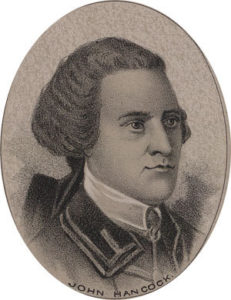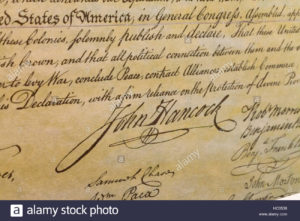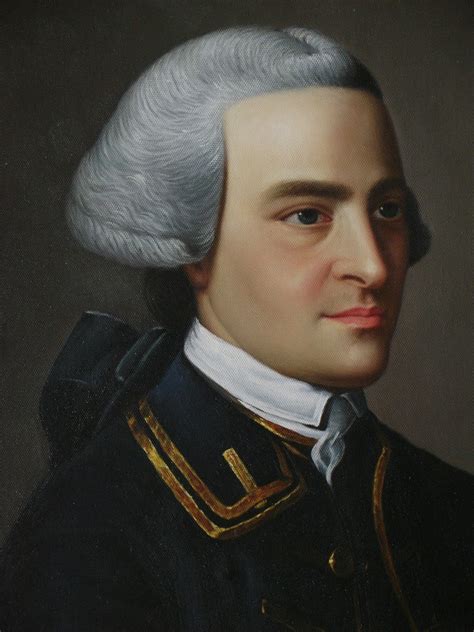CONSULTA LINK:
http://www.ushistory.org/declaration/signers/hancock.html
https://www.biography.com/people/john-hancock-9327271
John Hancock nacque a Braintree (adesso Quincy), in Massacchussets, il 23 gennaio del 1737, da Mary Hawke e John Hancock, un pastore evangelico.
Quando suo padre morì nel 1744 venne adottato da un ricco zio che svolgeva il mestiere di mercante, Thomas Hancock, e non aveva figli.
 Hancock frequentò l’università di Harvard e si diplomò all’età di diciassette anni.
Hancock frequentò l’università di Harvard e si diplomò all’età di diciassette anni.
Diventò un impiegato per suo zio, proprietario di un’azienda, nota come House of Hancock (Casa di Hancock), che importava prodotti dalla Gran Bretagna ed esportava rum, olio di balena e pesce, e nel 1760 fu mandato in una missione commerciale in Inghilterra, dove assistette all’incoronazione di Giorgio III e assunse alcuni dei più importanti uomini d’affari di Londra.
Tornò nelle colonie e nel 1762 divenne un membro della Loggia Massonica di Sant’Andrea.
Quando suo zio morì nel 1763, ottenne una grande eredità e per questo motivo cominciò a frequentare una società di uomini che era composta principalmente da lealisti, persone che non erano viste positivamente dalla popolazione a causa della loro ricchezza e del loro potere sociale.
John iniziò ad essere coinvolto nella politica rivoluzionaria e voleva l’indipendenza dalla Gran Bretagna. Frequentava John e Samule Adams e altre figure di spicco del movimento repubblicano nel New England. Fu eletto all’Assemblea di Boston nel 1766 e diventò un membro del Congresso dello Stamp Act.
Nel 1768 il suo brigantino, la Liberty, fu sequestrato dai doganieri, chiamati tidesmen, al porto di Boston, con l’accusa di contrabbando. Un gruppo di privati cittadini attaccò la dogana, bruciò l’imbarcazione del governo e ferì i doganieri, che
 cercarono rifugio su una barca al largo. Hancock supportò il Boston Tea Party e l’anno seguente tenne un discorso pubblico davanti ad una grande folla a Boston, commemorando il Massacro di Boston.
cercarono rifugio su una barca al largo. Hancock supportò il Boston Tea Party e l’anno seguente tenne un discorso pubblico davanti ad una grande folla a Boston, commemorando il Massacro di Boston.
Fu eletto al Congresso Provinciale del Massachussets e al secondo Congresso Continentale. Hancock e Adams furono avvisati da Paul Revere durante la sua famosa cavalcata notturna del 18 aprile 1775, gridando che le forze britanniche erano sulla loro via, guidate da Thomas Gage. Hancock e Adams fuggirono da Lexington e andarono a Philadelphia, dove il Congresso si riunì nel maggio del 1775.
Quando Peyton Radolph si dimise nel 1776, Hancock diventò presidente del Congresso. Il suo ruolo presidenziale fu quello di una f

igura di rappresentanza e le decisioni del Congresso furono raggiunte generalmente attraverso un comitato. Sposò Dorothy Quincy, che veniva da una famiglia di mercanti. Da quel momento in avanti la fortuna commerciale di Hancock diminuì.
All’inizio del 1776 era stato fatto un decreto dall’Inghilterra che offriva una grande ricompensa per la cattura di numerose personalità di spicco e Hancock era uno di loro. Hancock fu il primo rappresentante a firmare la Dichiarazion e d’indipendenza il 4 luglio 1776, secondo cui le tredici colonie americane (stati) erano indipendenti dal dominio britannico. Firmò in uno spazio completamente vuoto. Alcuni dicono che firmando la Dichiarazione, Hancock abbia commentato: “Il ministero britannico può leggere quel nome senza occhiali, raddoppiare la loro ricompensa”. o altri: “Ecco, immagino che il re Giorgo sarà in grado di leggerlo!”, ma entrambe le storie sono infondate. La sua firma è la più appariscente e riconoscibile di tutte. Si ritirò nel 1777 a causa di alcuni problemi di gotta, ma continuò a partecipare alla creazione della costituzione del suo stato nativo. Qui prestò servizio nel Governatorato per cinque anni, declinò la rielezione e fu di nuovo eletto nel 1787. Prestò servizio in quell’ufficio fino al 1793, quando morì.
e d’indipendenza il 4 luglio 1776, secondo cui le tredici colonie americane (stati) erano indipendenti dal dominio britannico. Firmò in uno spazio completamente vuoto. Alcuni dicono che firmando la Dichiarazione, Hancock abbia commentato: “Il ministero britannico può leggere quel nome senza occhiali, raddoppiare la loro ricompensa”. o altri: “Ecco, immagino che il re Giorgo sarà in grado di leggerlo!”, ma entrambe le storie sono infondate. La sua firma è la più appariscente e riconoscibile di tutte. Si ritirò nel 1777 a causa di alcuni problemi di gotta, ma continuò a partecipare alla creazione della costituzione del suo stato nativo. Qui prestò servizio nel Governatorato per cinque anni, declinò la rielezione e fu di nuovo eletto nel 1787. Prestò servizio in quell’ufficio fino al 1793, quando morì.
Era un populista, che credeva nell’abilità dell’uomo comune e che mostrava un pronunciato disprezzo per l’autorità immotivata.
John Hancock was born in Braintree (now city of Quincy), Maussachussets, on January 23 (or 12), 1737, to Mary Hawke and the senior John Hancock, a clergyman.
When his father died in 1744 he was adopted by a wealthy merchant uncle, Thomas Hancock, who didn’t have children. Hancock attended Harvard College for a business education and graduated at the age of 17.
He became a clerk for his uncle, the owner of a firm known as the House of Hancock, which imported manufactured goods from Britain and exported rum, whale oil, and fish, and in 1760 was sent on a business mission to England, where he witnessed the coronation of George III and hired as employees some of the most
important businessmen of London.
He returned to the colonies and in 1762 and became a member of the Masonic Lodge of St. Andrew.
 When his uncle died, in 1763, he obtained a great inheritance and for this reason he started attending a society of men who were mainly composed by loyalists, people who were not seen in a positive light by the population because of their wealth and social power.
When his uncle died, in 1763, he obtained a great inheritance and for this reason he started attending a society of men who were mainly composed by loyalists, people who were not seen in a positive light by the population because of their wealth and social power.
John Hancock soon was involved in revolutionary politics and he wanted the independence from Great Britain. He was in company with John and Samuel Adams and other leaders in the republican movement in New England. He was elected to the Boston Assembly in 1766 and became a member of the Stamp Act Congress.
In 1768 his brig Liberty was seized by customs officers, called tidesmen, at Boston Harbor, on a charge of smuggling some goods.
A group of private citizens attacked the customs post, burned the government boat and beat the officers, who searched for a refuge on a ship off shore. Hancock supported the Boston Tea Party and the following year he made a public speech in front of a large crowd in Boston, commemorating the Boston Massacre.
He was elected to the Provincial Congress of Massachussets and to the second Continental Congress. Hancock and Adams were

John Hancock’s signature
warned by Paul Revere during his famous April 18, 1775 night ride shouting out that British forces were on their way, guided by Thomas Gage. Hancock and Adams fled Lexington and went to Philadelphia, where the Congress met in May, 1775. When Peyton Randolph resigned in 1776, Hancock was appointed Congress president. His presidential role was of a figurehead position and congressional decisions were generally achieved through committee. He married Dorothy Quincy, who came from a merchant family. From that moment on Hancock’s business fortune decreased.
A decree had been delivered from England in early 1776 offering a large reward for the capture of several leading figures and Hancock was one of them.
Hancock was the first representative to sign the Declaration of Independence on July 4, 1776, which said that the thirteen American colonies (states) were independent from the British rule. He signed in an entirely blank space. Some people say that on signing the Declaration, Hancock commented: “The British ministry can read that name without spectacles; let them double their reward.” or others: “There, I guess King George will be able to read that!”, but both stories are unfounded. His signature is the most garish and recognizable of all.
He retired in
 1777 because of some problems with gout, but continued participating in the formation of the constitution of his native state. There he served in the Governorship for five years, declined reelection and then was again elected in 1787. He served in that office until 1793, when he died.
1777 because of some problems with gout, but continued participating in the formation of the constitution of his native state. There he served in the Governorship for five years, declined reelection and then was again elected in 1787. He served in that office until 1793, when he died.
He was a populist, who believed in the ability of the common man and who showed a pronounced disdain for immotivated authority.
ARTICOLO REDATTO DALLA ALLIEVA MUSSO VANESSA CON LA SUPERVISIONE DELLA PROF. ORIANA MAFFEO


Commenti recenti